Practising Visual Methods
Researchers from a variety of disciplines and countries flock to Leiden in August. Exploring the ‘ordinary’, showing emotion, and challenging existing images: they tell what draws them to spend their summer on audiovisual methods.
The specialisation in Visual Anthropology in Leiden has been ticking along nicely since the 1960s. But recently its popularity has surged, both inside and outside anthropology’s own disciplinary borders. Audiovisual methods – as we currently call them – now receive such recognition that some people devote their holiday to practiscing these methods with us at our summer course.
Participants are all looking for a whole mixture of methods to fit their own specific purposes. I will let them speak for themselves through a compilation of a spontaneous discussion in class (recorded on my mobile) as well as quotes from written reflections. All of them were glad to give their consent for me to publish their comments on this blog.
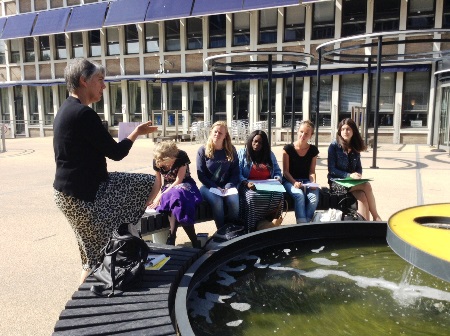
Lecturing Visual Methods in the summer sun
Three dimensional history
Joyce Zoe Farley (US), PhD candidate AAAS, Michigan State University
"Coming both from journalism and oral history in the States I’d say that visual methods allow history to come alive. For the most part it is very much textual, very black and white, static. Audiovisuals allow it to become more three dimensional; it is very much sensorial, you are allowed to step into that place in time. But not only that: visuals stick better than text.
Visuals show emotion
Daniel Gomez (NL), PhD candidate PETGOV, University of Amsterdam
"Words are amazing to express what I do, but I find it is not enough sometimes. In my department they have such nice tables explaining why migration happens in certain ways in certain countries. But something they don’t know – that I think is a source of explanation too – is emotion. As social scientists we try to understand why we as human beings behave in certain ways, right? So audiovisuals add another level.
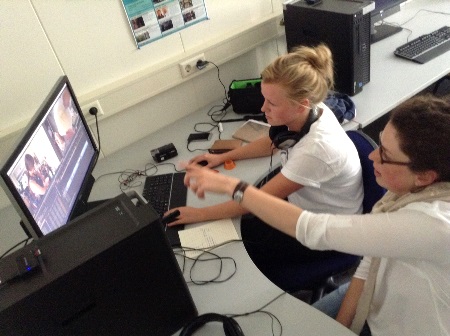
Workshop editing by Ildikó Plájás
Inclusiveness and experience
Stacey MacDonald (NL), PhD candidate KITL, Leiden University
"Yeah, when you are writing you can’t always take all factors that are at play at the same time into consideration. Visual methods make it easier to capture all the different elements. You can still maybe focus on the emotional part, but you see the social aspects of it too; you see the role of someone’s personality, you see the interaction with other people, etc. So you don’t exclude various elements that influence behaviour. Visual methods automatically capture the fact that a lot of factors play a role, whereas quantitative data select – and reduce – more.
That the visuals stick better than text - that has to do with experience. People learn and know through experience; that is a proven method for getting knowledge across, and watching a film is an experience."
Generating cross-cultural understanding
Elise van Nunen (NL), BA University of Utrecht
"Cultural anthropology can be defined as a discipline dependent on long-term fieldwork and a bottom-up perspective on social life and can, therefore, generate first-hand knowledge. I view generating cross-cultural understanding as one of the main goals.
Visual information, for some reason, impacts people in different ways then textual information. Do you not feel more empathy and understanding for someone you see struggling in front of you than when you read about it? This is not to deny the importance of textual information, merely [to plead] for the acceptance of audiovisuals as part of our method.
Recording is definitely more difficult than it seems. Trying to move with the subject, I found myself moving the camera too much… It is difficult to simultaneously consider the framing, the technical aspects, the subject, and the way the narrative evolves. Editing is complicated as well, but there is less of a feeling of ‘now or never’. Dilemmas arise because of choice or lack of choice – and I experienced both. I ended up returning and shooting another day. Next time I’ll elaborate more on what type of shooting style I want to use. With this in mind, I’ll try even more to record with editing in mind."
Stepping out of my comfort zone
Annemarie Voortman (NL), Wageningen University
"The biggest dilemma was about filming people in a place where they feel comfortable. I felt like I was intruding. Through the camera I was confronted with my own shyness. It is important to win trust first, by investing time. What I also found difficult was to find a focus; in the first days I felt overwhelmed, as it was a new environment for me. The hardest thing I encountered during editing was trying to construct an argument with image."
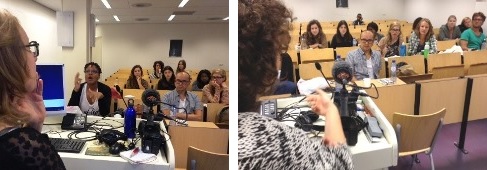
Discussing Visual Methods
Constructing ‘reality’
Anouk Houtman (NL), BA VU University Amsterdam
"The conventional way of constructing films is culturally biased. If your spectators are scholarly, you can break more of those conventional rules without scaring them away immediately. If you want to show rather than tell, in a more ethnographic manner, you don’t want to objectify people by forcing them in a storyline in order to appeal to a general audience. So mainstream editing might not be the best option then.
The writer of a text always has the power to decide what to write down and in what order: what to include and what to exclude. So a text is constructed. As is a film. So in relation to representing ‘reality’, it shouldn’t matter what methods you use, audiovisual or text. They’re both valuable.
As an anthropologist you’re very interested in the meaning people give to their lives, so you will want to include audiovisual data because of body language and tone of voice, since that determines how things are meant. Also, by letting people film or take photographs themselves, you can get a better understanding of what they see as important and how they see their own lives."
Acknowledge the ‘other’, explore the ‘ordinary’
Georgie Edmonds (UK), BA Cambridge University
"The ability of film to capture non-verbal communication and the feel of a certain place – and sharing that phenomenological experience – seems something essential that is often overlooked in anthropological discourse.
I also shared my footage with my main character frequently and kept him updated about my ideas, giving him the chance to share ideas and his opinions about my project. On the one hand, I had the authority, with my choice of shots and research focus. On the other, the subjects of my film were able to change, disagree, and disrupt such authority.
Therefore the knowledge I produced was a collaborative project of ‘everyday knowledge’. Anthropology’s aim (for me) is not to produce objective, definite, and factual knowledge, but rather to explore the beauty and compelling nature of the ordinary."
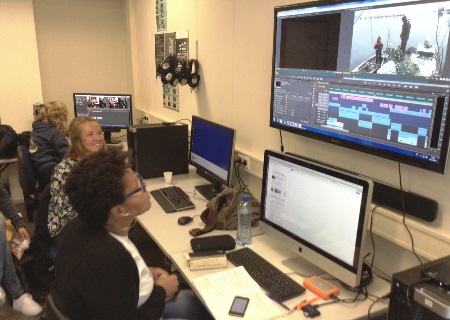
Editing in progress
The invisible visible, challenging existing images
Julia Chanda Zvobgo (NL/ZW), Political Science
"I want my work to dispel assumptions and challenge the existing images and visual representations of black experiences. I am interested in making the invisible visible – and what better way to make people consider others but by seeing and hearing them.
Audiovisual methods provide additional insights for researchers as well, for example: looking back at my rushes and seeing the physicality involved in preparing food created an impact. The visual got me thinking back on the actual process of having to hold the hot pot to steady it and the pain that comes from needing to hold the wooden spoon so tightly, which in turn made me think of some other African rituals that help communicate African cultural common sense, i.e. Some things are going to hurt but you just have to get on with it.
Whether it’s making ‘fufu’ or getting your hair done – children (mostly girls) are taught to tolerate the pain and be stoic. This helps you accept socially required conventions that involve pain and also helps prepare you for tough situations. This can be a strength or a weakness: in Zimbabwe, for example, women who are victims of domestic violence are expected to stay, not complain, and work through the pain."
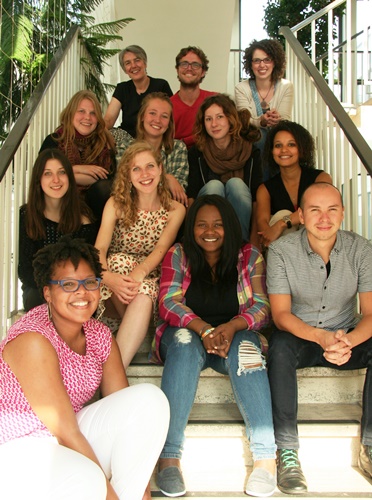
Summer Course participants of 2015
Thinking behind the technology
The accessibility of contemporary audiovisual technologies allows more and more scholars like these young students and PhD researchers to broaden the scope of their methodology and communication techniques. If this trend continues we’ll see many more training ‘boot camps’ like our summer course.
Because, everyone may have a mobile, but having a pen in your pocket does not make you an academic. It is the thinking behind the technology available that kept us busy in August.
Interested to see some footage? Watch the Summer Course promo with film fragments of our 2015 participants:


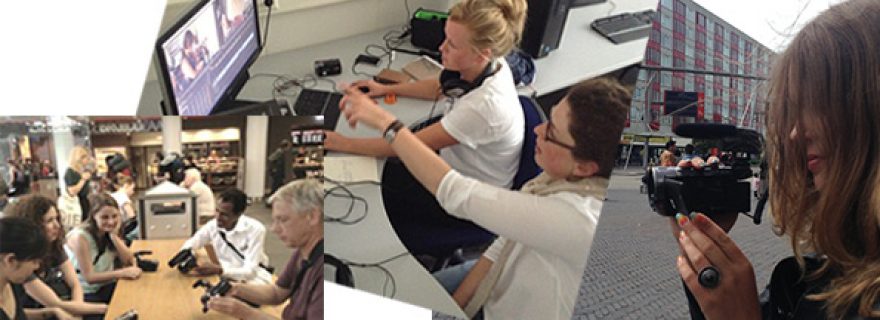
0 Comments
Add a comment